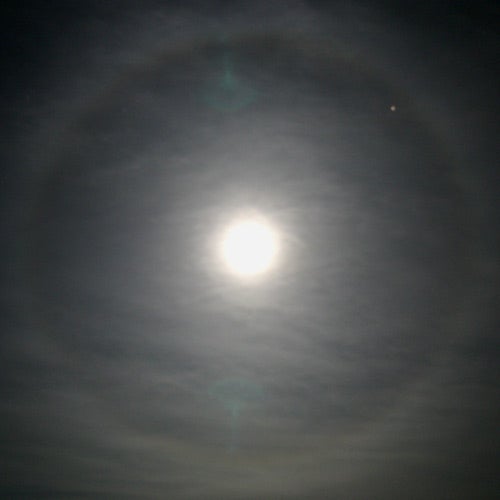Moon halos occur when you see the Moon through a sheet of randomly oriented ice crystals high in the atmosphere. Ice crystals have a hexagonal shape and take two forms. One is columnar and resembles an unsharpened golf score-sheet pencil. The other form is plate-like and mimics a hexagonal bathroom-floor tile.
To produce a Moon halo, light passes through one side of the pencil-like crystal and emerges from another side. It makes two refractions and is deflected 22° from its original path. The refraction has the effect of concentrating light rays around the Moon 22° away from it, or about as far as a hand held at arm’s length can spread. The ring has a width of about 1.5°, or 3 Moon-diameters.
Because the light passes through the crystals, each acts as a tiny 60° prism, splitting the moonlight into colors. The most visible color is a reddish tinge seen on the ring’s inner edge, which is more sharply defined than the outer edge. Because the ice crystals are not optically perfect prisms, ring colors seldom appear vivid or intense.
In the case of the tile-like crystals, light can pass through one flat face and one side, being bent 46°. This creates a different ring about twice as far away from the Moon (or Sun). The 46° halos, however, are fainter and seen less often. Still, whenever you spot a 22° halo, take a look farther out for the wider halo. (Try covering the Moon or Sun with your thumb.) Observers who check out the sky frequently usually catch sight of 22° halos at least a few times a month. The 46° halo is a lot less common.
The meteorological condition most likely to produce halos is an approaching warm front. This occurs when warm, moist air is lifted over a layer of colder air. As the leading edge of the warm air mass moves overhead, its high, thin ice clouds can produce the halo. Later, when the bulk of the warm air mass lies closer to you, clouds are generally too thick to produce a halo, and rain (or snow, depending on season) is probably in your forecast. Thus, the old wives’ tale of halos around the Moon or Sun foretelling rain in 12 to 24 hours has some grounding in truth. — ROBERT BURNHAM, MARS SPACE FLIGHT CENTER, ARIZONA STATE UNIVERSITY










